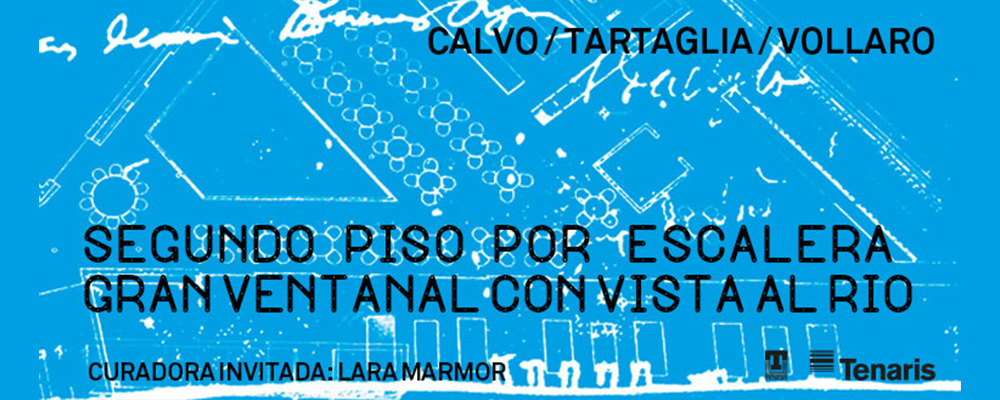PRESENTATION
Contemporary Space
Second floor by stairwell. Large windowpane with river view
Beginning Saturday, June 28, 2014, the Contemporary Space presents the exhibition Second floor by stairwell. Large windowpane with river view, with Lara Marmor as the guest curator and the interventions by artists Eugenia Calvo, Leandro Tartaglia and Ivana Vollaro.
Based on the museum´s architectural design and café space, the three interventions of the curatorial proposal developed by Lara Marmor - a sculptural piece of Eugenia Calvo, anaudible play by Leandro Tartaglia and an architectural intervention byIvana Vollaro - reflect on the spatial and symbolic relationship with the outside world; as the curator notes, the exibition "proposes to transcend the physical conditions of the architecture, subtly and intelligently altering the relationship between interior and exterior."
Second floor by stairwell. Large windowpane with river viewis the first of the four proposals selectedduring the encounter Project Selection 2014/2015. The decision was made by the Contemporary Space in March 2014 with the aim of selecting site-specific intervention projects and generating a pedagogical space for exchange and debate on contemporary interventions.
+ http://www.proa.org/eng/news-nota.php?id=671
Second floor by stairwell. Large windowpane with river view
by Lara Marmor
Le Corbusier and his walls of light. Le Corbusier spent a great deal of time pondering the form and function of windows until he came up with the wonderful idea of the picture window understood as wall of light. In 1923, he designed La Ville La Roche whose most important feature was the large window. The architect had proposed something novel for the time: the dematerialization of the walls. Thus, a house became an apparatus from which to look at the world and a place where the landscape became part of the building’s interior. Second floor by stairwell. Large windowpane with river view [Segundo piso por escalera. Gran ventanal con vista al río] revolves around a reflection on the connection between interior and exterior, between La Boca neighborhood, the Riachuelo River, and Proa.
When they imagined museums with neither facades nor walls, Le Corbusier and Malraux’s ideas seemed utopian. But, starting in 1980, museums opened up to the outside world with projects and programs geared toward a wider community and greater public circulation. PROA’s overarching vision partakes of that openness. The café—the focus of our work—provides one of the most picturesque and, at the same time, sordid views of city; it incites reflection on how the relationship with the exterior is constructed.
The project. The architectural design of the building is our point of departure. On the occasion of its tenth anniversary, Proa remodeled and expanded its premises. The most important feature of the new proposal is the large glass façade.
The operating principles of transparency and openness suggested by this large pane of glass are the triggers for this exhibition. Before the river, Eugenia Calvo’s sculpture, Leandro Tartaglia’s sound-based theater piece, and Ivana Vollaro’s architectural intervention set out to go beyond the physical conditions of the real architecture, subtly and intelligently shifting the interior-exterior relationship.
The works.Eugenia Calvo places an iron structure on the terrace’s ledge, turning the wall into a walkway. Like an architectural prosthesis, this sculpture suggests the possibility of walking on the borderline that separates La Boca from the museum. S/T (argumento) [Untitled (plot)] proposes inhabiting the meeting point between the two worlds, daring to explore the frontier zone, which always proves more enlightening than walking down the middle of the road.
Leandro Tartaglia premieres his Un vaso de agua [A Glass of Water]. The audience sits at a certain table, puts on headsets, pushes the “play” button, and drinks a glass of water. The words heard reveal the shared history of the water in the glass and the water in the Riachuelo, while the sounds of water circulating both inside and outside the building mingle, rendering the relationship between the exterior and the interior concrete.
Ivana Vollaro builds a platform to raise a table and its chairs. Those who sit here discover the landscape that the terrace wall normally conceals. Vollaro often works with the notion of slippage, and this platform becomes part of the café´s design; it is perceived as a component of the architecture not as a work of art. Para estar a la altura [To Reach the Height] disempowers the wall as visual obstacle, effectively shifting the location’s limits.
The three works have the shared charm of filtering into the silence of the landing when the view of the river is seen from the second floor. They incite exploring a limit, crossing a border, and having an unexpected experience. They invite us to listen to the stories and sounds that lie within water and the possibility of looking beyond from elsewhere.
Créditos
Opening
Sábado 5 de julio
-
Artists
Eugenia Calvo/Leandro Tartaglia/Ivana Vollaro
-
Guest curator
Lara Marmor
-
Contemporary Space Coordinator
Santiago Bengolea
-
Acknowledgements
Many thanks to all those who made possible and participated in the curatorial workshops organized by Fundación PROA, in particular Florencia Qualina, Guillermina Mongan, Guadalupe Chirotarrab, and Osías Yanov. Thanks as well to Santiago Bengolea, Rosario Güiraldes, and Gala Galardi.
-
Sponsor
Tenaris – Organización Techint
